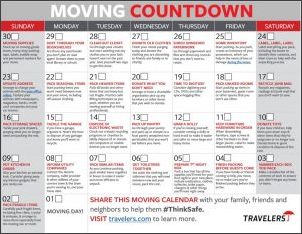May is National Moving Month. If you’re looking to move your business, this kind of a move is typically more involved and comes with bigger hazards than a residential move. You need to consider the impact an office move will have on your customers and anticipate any challenges that could occur during the move that may result in lost revenue for your business.
The article below was written by Mike Perry of North Dallas Moving and Storage and is shared with permission. Keep reading to learn how you can efficiently move your business without losing productivity or revenue. Although the tips are specific to a business move, this blog contains helpful tips that anyone can use — whether planning for a business or residential move. At the end, you’ll also find links to other articles containing tips for moving to a new home.
Find a Reliable Moving Company
One of the most important aspects to any successful moving endeavor is to hire a reputable moving company you can trust. While many people want to go cheap when they hire a mover,  the fact is that a moving company can make or break your move, and spending the money to hire a top-shelf company saves you aggravation and lessens the stress you’ll have worrying about whether things are getting done right.
the fact is that a moving company can make or break your move, and spending the money to hire a top-shelf company saves you aggravation and lessens the stress you’ll have worrying about whether things are getting done right.
When looking for a reputable moving company, look for one that will take inventory of your things to ensure everything is accounted for before, during, and after the move. Also, make sure you get references from other companies who have used the mover you’re looking at, and don’t be shy about asking the mover for those references. Any reputable moving company will gladly give you a list of people you can contact to ask them about their experience.
Make a Detailed Plan
To successfully move your business, it’s essential you come up with a plan as early on in the process as possible. This plan should include all members of your team, and detail all the logistical concerns required by each department to ensure the move comes off without a hitch.
Make a Detailed Inventory

Offices have a lot of ‘stuff’ that needs to be moved, which includes furniture, office equipment, computers, phones, files, office supplies, etc. When you’re creating your plan, create a detailed list of everything that needs to be moved and a list of those things which you can recycle or throw away. This list will also be helpful to the moving company to ensure everything is accounted for once it arrives at its new location.
Note from Kathy Paauw: One of the best tools I have found for creating a moving inventory is The Paper Tiger, which comes with a guarantee that you can find anything you file or store in 5 seconds or less. I have been using it since 1996 and it’s a great way to inventory everything you put in boxes for a move. You can also categorize the boxes by location (which office they go in). By using The Paper Tiger, you can find things quickly before you unpack and can organize things for your move much more effectively. If you’d like to see how The Paper Tiger works, register for my free webinar, Find Anything in 5 Seconds or Less.
Create a Timeline
Having a timeline for accomplishing goals will help you ensure that you’re on track so that the move happens as smoothly as possible. This timeline might include items such as what day you need to be out of the office by, when you will turn off services such as phone and electricity, and when you can expect to be up and running again in your new location. It’s difficult, to be sure, but try to nail down as many of these aspects as you can because the more you can plan for before you begin, the smoother things will go and the less surprises you’ll have.
Get Your Team on Board
 If you have an office with a medium to a large staff, get them involved by assigning them tasks to make the move happen quickly and efficiently. Tasks can be as simple as packing or making sure that the post office is notified of the change of address. The goal here is to keep everyone involved and delegate the work, which helps to ensure that nothing gets missed.
If you have an office with a medium to a large staff, get them involved by assigning them tasks to make the move happen quickly and efficiently. Tasks can be as simple as packing or making sure that the post office is notified of the change of address. The goal here is to keep everyone involved and delegate the work, which helps to ensure that nothing gets missed.
It’s also vital you keep your employees up to date and get feedback from them by having regular meetings leading up to the move. This allows everyone to feel as if they have a hand in the process and allows management to get vital feedback in the event that something doesn’t look right or if there’s a potential problem they’re not aware of.
Communicate with Customers & Vendors
 Another vital step to ensure that you have a successful move is to notify your customers as far in advance as possible before you move. Make sure they know the last day you’ll be available at your current location and when they can contact you again at your new location. Also, make your vendors aware of your plans to move so they can begin to schedule deliveries and services so you’ll be able to hit the ground running when you set up in your new digs.
Another vital step to ensure that you have a successful move is to notify your customers as far in advance as possible before you move. Make sure they know the last day you’ll be available at your current location and when they can contact you again at your new location. Also, make your vendors aware of your plans to move so they can begin to schedule deliveries and services so you’ll be able to hit the ground running when you set up in your new digs.
Prepare the New Office
If you can, get as much done at your new place as possible so you’re ready to move in and get straight to work once everything is in place. Make sure the office is clean and that you have a game plan for where everything is going to fit in so you don’t have to make these decisions while the movers are unloading the truck.
What’s Next?
 Moving a business is a challenging task. How do you get started with organizing for a move?
Moving a business is a challenging task. How do you get started with organizing for a move?
The first thing is to schedule some time to implement the tips outlined above. Once you’ve got some working sessions reserved on your calendar, you’ll be well on your way to creating a more organized move. When you plan thoroughly and hire a reputable mover to help, you can be ready to go when you arrive at your new place with minimal stress. To see a larger view of the calendar to the right, click on the graphic.
If you’d like to explore the possibility of getting some help putting systems in place so you can be more productive, let’s schedule a no-cost discovery call today.
Additional Articles from North Dallas Moving and Storage:
- The Easy Way To Move Plants To Your New Home
- Ways to Stay Calm Through the Chaos of Preparing for a Move
- How Keep Your Cool When You Have A Last-Minute Move
Additional Resources:
- Free Webinar: Find Anything in 5 Seconds or Less
- Blog: Tame Your Paper Tiger
- Free Moving Countdown 30-Day Calendar

Life Architect – Creating Blueprints for Purposeful & Productive Lives
Kathy@OrgCoach.net www.OrgCoach.net Follow me on Facebook






Every year, the grass on the other side of the fence looks greener to many entrepreneurs, and a change of place looks like the most promising path to growth. So they pull up stakes and move to a new place, where they hope to find better odds for business success than they had in their previous location. They’re in good company. The U.S. Census Bureau reports that approximately 40 million Americans relocate each year, and the U.S. Postal Service processes about 38 million change-of-address forms annually. Although no one keeps a similar count of business moves, given the multitude of valid business reasons for making a move, almost any entrepreneur will, at some time, consider relocating as a way to expand.
Yes, you are so right that many people move a business for a multitude of reasons. In my area, the owners of the buildings that businesses have leased for years are being torn down to make room for new highrise condos and upscale storefronts. Many businesses can no longer afford the increase in their lease, so they are forced to move to a less expensive spot.